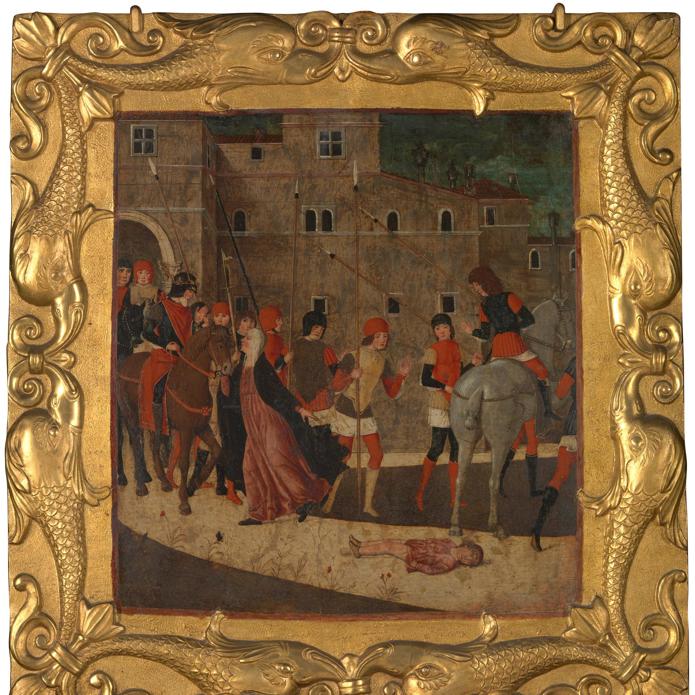Italian, Veronese, 'The Widow's Petition', probably about 1475-1500
About the work
Overview
This is one of a pair of panels from a piece of painted furniture, a cassone (large chest). They show the story of the Roman Emperor Trajan, widely known from Jacopo da Voragine’s Golden Legend of about 1260 and retold by Dante in the Divine Comedy in the early fourteenth century. As Trajan prepared to leave for a military campaign, a widow asked for justice for her son, who had been killed by Trajan’s own son. He promised this on his return, but, after she pointed out that he might not come back, he duly held a court.
Here, in the first scene in the story, the mounted Emperor, dressed in mail and with a crown, is riding out of the gate of a city, accompanied by his soldiers. The distressed widow points to the body of her son, which lies in the road. Trajan’s followers throw their hands up in horror at the sight of the child.
Key facts
Details
- Full title
- The Widow's Petition
- Artist
- Italian, Veronese
- Part of the series
- Cassone Panels with Scenes from the Life of Trajan
- Date made
- probably about 1475-1500
- Medium and support
- egg tempera on wood
- Dimensions
- 34 × 31.5 cm
- Acquisition credit
- Bought, 1883
- Inventory number
- NG1135
- Location
- Not on display
- Collection
- Main Collection
Provenance
Additional information
Text extracted from the ‘Provenance’ section of the catalogue entry in Martin Davies, ‘National Gallery Catalogues: The Earlier Italian Schools’, London 1986; for further information, see the full catalogue entry.
Bibliography
-
1951Davies, Martin, National Gallery Catalogues: The Earlier Italian Schools, London 1951
-
1986Davies, Martin, National Gallery Catalogues: The Earlier Italian Schools, revised edn, London 1986
-
2001
C. Baker and T. Henry, The National Gallery: Complete Illustrated Catalogue, London 2001
About this record
If you know more about this painting or have spotted an error, please contact us. Please note that exhibition histories are listed from 2009 onwards. Bibliographies may not be complete; more comprehensive information is available in the National Gallery Library.
Images
About the series: Cassone Panels with Scenes from the Life of Trajan

Overview
These two panels once adorned a cassone, a large decorated chest. Cassoni were prestigious and expensive items of furniture, and they often showed scenes from classical poetry or history; battles and moral stories were especially popular. A number of surviving late fifteenth-century cassoni from Verona depict the tale shown here, the so-called Justice of Trajan.
The extravagant frames with their paired dolphins are nineteenth-century replacements for the original pastiglia (raised decoration made from liquid plaster) frames. They were probably very similar to those on a large chest in the Detroit Institute of Arts, the front of which has two panels in decorative pastiglia frames on either side of a central panel, also in pastiglia, with a coat of arms. This seems to have been a popular arrangement in late fifteenth-century Verona, and our panels were presumably originally arranged in the same way.


